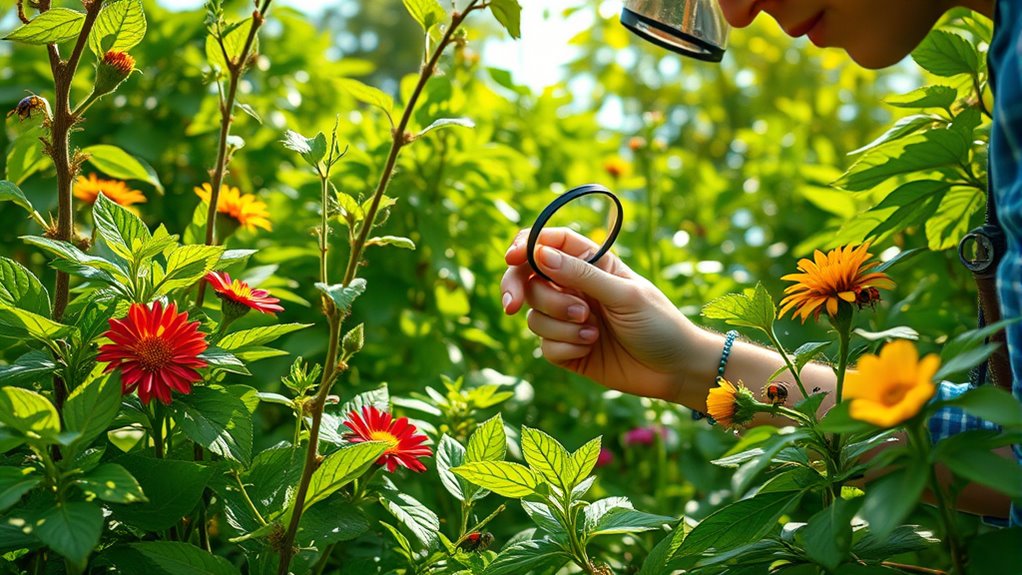Integrated Pest Management (IPM) is a proactive approach that combines regular pest monitoring, biological controls, and targeted interventions to keep pests under control. By regularly inspecting your garden and understanding pest behavior, you can catch issues early and decide if action is needed. Using natural predators and minimal chemicals helps protect your plants and the environment. Keep exploring to discover how implementing IPM can help you maintain a healthier, balanced garden.
Key Takeaways
- IPM is a sustainable approach combining pest monitoring, biological control, and targeted interventions to manage pests effectively.
- It emphasizes early detection and prevention to reduce pesticide use and protect beneficial organisms.
- Regular monitoring using tools like traps and visual inspections guides timely, precise pest management actions.
- IPM promotes ecological balance by integrating natural predators and minimizing chemical treatments.
- The strategy aims for healthier plants and a healthier environment through proactive, informed pest control.

Pest monitoring is another essential component of IPM. It involves regularly inspecting your garden for signs of pests or damage. This proactive approach helps you catch issues early before they become severe. By closely observing your plants, you can identify which pests are present, how many there are, and whether they pose a genuine threat. Pest monitoring also helps you determine if and when action is necessary, preventing unnecessary pesticide applications. Using tools like sticky traps, visual inspections, or even smartphone apps can make this process easier and more accurate. Additionally, understanding how materials influence pest behavior and plant health can enhance your monitoring strategies.
Together, biological control and pest monitoring create a feedback loop that allows you to respond precisely to pest problems. When you notice a few pests, you can assess whether they are enough to cause damage or if natural predators are already managing the situation. If pests become abundant and threaten your plants, you can then implement targeted control methods—such as releasing beneficial insects or using organic treatments—rather than blanket chemical sprays that can harm beneficial organisms and pollute your environment.
Implementing IPM might take some effort upfront, like learning to identify pests and beneficial insects, but it pays off by promoting healthier plants and a balanced ecosystem. It’s about understanding that not every pest needs to be eradicated immediately and that working with nature often yields better results than fighting it. By integrating biological control with vigilant pest monitoring, you create a resilient, environmentally friendly gardening system that keeps pests in check while nurturing your plants and the broader environment.
Frequently Asked Questions
How Does IPM Compare to Traditional Pest Control Methods?
Compared to traditional pest control methods, IPM emphasizes sustainability benefits by reducing chemical use and focusing on long-term solutions. You’ll find it more environmentally friendly and safer for your garden. Cost considerations also favor IPM, as it minimizes pesticide expenses and damage repairs. You actively monitor pests, target only problem areas, and promote natural pest control, making it a smarter, more sustainable choice for your garden’s health and your budget.
Are There Specific Tools or Products Used in IPM?
Imagine having subtle allies in your garden; that’s what you get with IPM tools. You’ll use biological controls like beneficial insects to naturally reduce pests and mechanical traps to catch troublemakers early. These tools work together to maintain a healthy balance, minimizing chemical use. By choosing these effective, eco-friendly options, you protect your garden’s beauty while promoting sustainable pest management.
Can IPM Be Applied to Organic Gardening Practices?
Yes, you can apply IPM to organic gardening practices, as it aligns with sustainable practices and organic compatibility. You focus on monitoring pests closely, encouraging natural predators, and using organic-approved control methods. This approach minimizes chemical use, supporting healthy soil and plant growth. By integrating biological, cultural, and physical controls, you create a balanced garden environment that reduces pest problems naturally and sustainably.
What Are Common Mistakes to Avoid With IPM?
Think of IPM as tending a garden like a delicate dance—you need to watch closely and respond at the right moment. Avoid common mistakes like overuse pesticides, which can harm beneficial insects, or neglect monitoring, causing pest problems to spiral out of control. You might miss early signs of pests if you’re not paying attention. Staying vigilant and using targeted methods helps keep your garden healthy without unnecessary chemical use.
How Long Does It Typically Take to See Results With IPM?
You might wonder how long it takes to see results with IPM. Timing expectations vary, but generally, you can expect to notice visible signs of pest reduction within a few weeks. Consistency is key; as you implement strategies, pests will decline gradually. Keep monitoring your garden, and you’ll see healthier plants and fewer pests over time, usually within one to three growing seasons, depending on the severity of the infestation.
Conclusion
By embracing integrated pest management, you’re becoming a gardener who dances in harmony with nature’s rhythms. Think of it as tuning your garden’s symphony, where every pest is a note to be managed gently. With patience and care, you’ll nurture a thriving landscape, like a painter blending colors to create a masterpiece. Remember, your garden’s health is a delicate balance—tend to it wisely, and it’ll reward you with beauty and bounty beyond your dreams.









